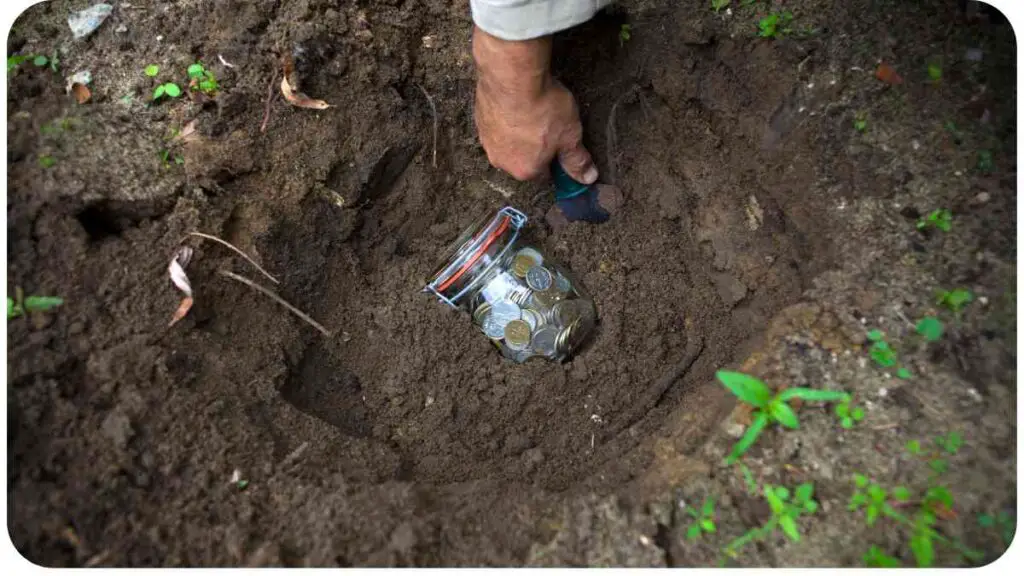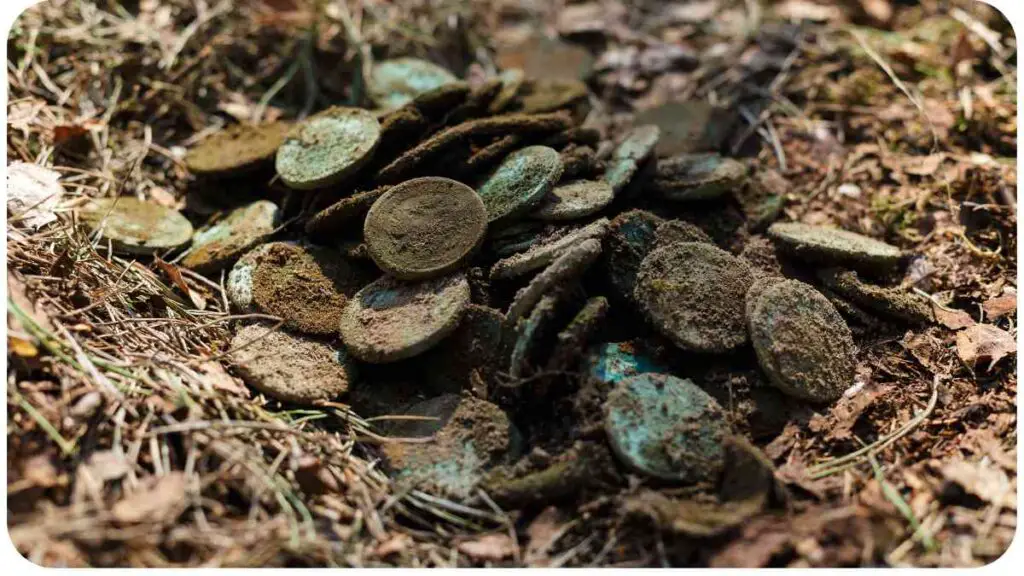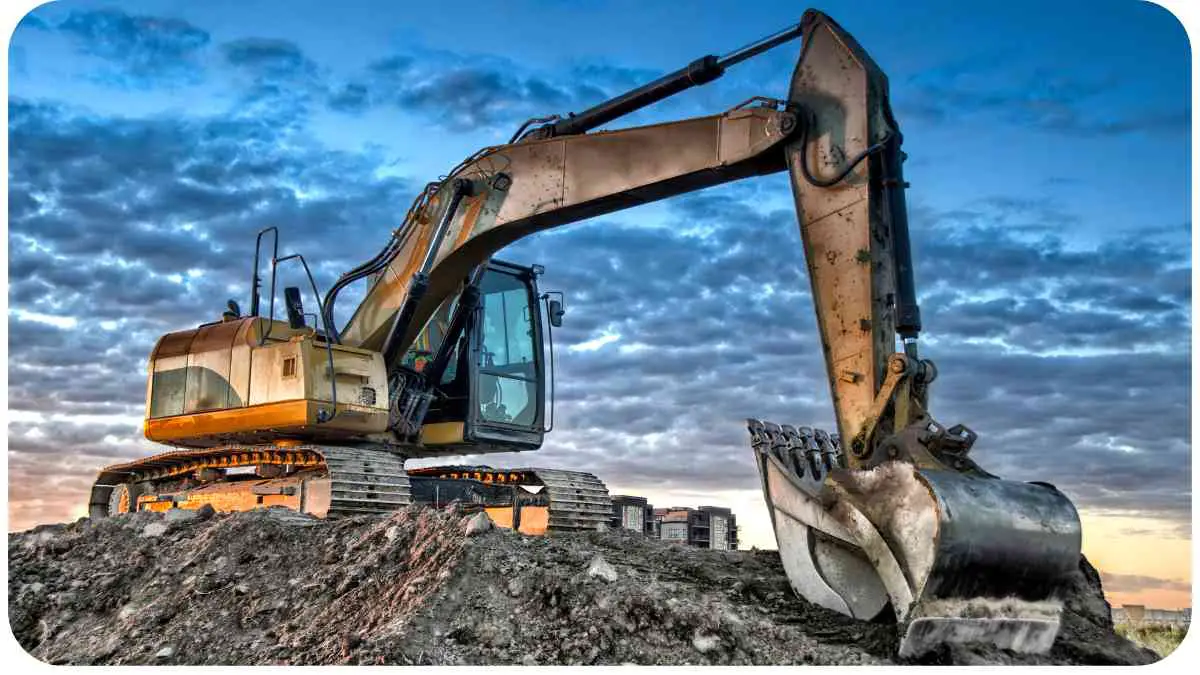Greetings, fellow treasure enthusiasts! Have you ever dreamed of unearthing hidden treasures and ancient relics? If so, you’re in for a treat. But before you embark on your quest, it is essential to understand the concept of Leave No Trace and how to dig for treasure responsibly.
This guide will provide you with valuable insights and tips on how to minimize your impact on the environment, ensure legality, and contribute to preserving our rich heritage.
| Takeaways |
|---|
| Respect historical sites and obtain necessary permissions |
| Choose a treasure digging location with historical significance |
| Use the right tools and employ proper digging techniques |
| Fill and reinstate the excavation site to minimize impact |
| Be mindful of personal safety and legal obligations |
| Minimize disturbance to flora, fauna, and wildlife habitats |
| Share knowledge and discoveries with the treasure hunting community |
| Practice proper etiquette and respect fellow treasure hunters |
| Dispose of waste properly and leave no trace |
| Preserve artifacts and maintain a responsible treasure digging approach |
2. Understanding the concept of Leave No Trace
2.1 Definition of Leave No Trace
In its essence, Leave No Trace refers to the set of principles and practices that promote responsible and sustainable land use. Whether you’re hiking, camping, or engaging in activities like metal detecting, Leave No Trace principles apply to ensure minimal impact on the environment and cultural resources.
Exploring abandoned buildings unveils a world frozen in time, revealing tales of the past. Dive into the mystery of forgotten spaces and unearth hidden treasures by exploring abandoned buildings.
2.2 Principles of Leave No Trace
Table 1: Leave No Trace Principles
| Principle | Description |
| Plan ahead and prepare | Research and prepare for your treasure-digging expedition |
| Travel and camp on durable surfaces | Minimize trampling and damage to flora and soil |
| Dispose of waste properly | Pack out all trash and dispose of it in designated areas |
| Leave what you find | Preserve historical artifacts by not taking them with you |
| Minimize campfire impact | Follow local regulations and minimize fire-related damage |
| Respect wildlife | Observe animals from a distance and do not disturb their habitat |
| Be considerate of other visitors | Show respect and courtesy towards fellow treasure hunters |
By adhering to these principles, we can ensure that our treasure hunting experiences are not only enjoyable but also environmentally responsible.
3. Choosing the Right Location for Treasure Digging

Now that you understand the importance of Leave No Trace, let’s discuss how to choose the right location for your treasure digging adventure.
3.1 Researching Historical Sites
Research is the key to successful treasure digging. Start by exploring historical records, maps, and local archives to identify potential sites with historical significance. Look for areas where people historically congregated, such as old settlements, battlefields, or popular recreational spots.
3.2 Obtaining Permissions
Before you start digging, it’s crucial to obtain the necessary permissions. Some locations may require permits or agreements with landowners, local authorities, or archaeological organizations. Respecting private property and obtaining proper permissions not only ensures legal compliance but also builds trust within the community.
Embark on a maritime adventure to uncover the secrets of the deep sea. Delve into the captivating world of shipwreck salvage operations, where history lies beneath the ocean’s surface, waiting to be rediscovered.
3.3 Respecting Protected Areas
Certain areas, such as national parks, wildlife preserves, and protected archaeological sites, have strict regulations to preserve their ecological and historical integrity. Respect these regulations and avoid carrying out any treasure digging activities within these protected areas.
Table 2: Factors to Consider when Choosing a Location
| Factors to Consider | Description |
| Historical significance and potential | Research the history of the area and identify potential sites |
| Accessibility and permissions | Ensure you have the necessary permissions and legal rights to dig in the chosen area |
| Environmental and ecological sensitivity | Avoid fragile ecosystems and protected areas |
| Local regulations and restrictions | Familiarize yourself with laws and guidelines governing treasure digging |
| Table 3: Factors to Consider when Choosing a Location for Treasure Digging |
Take into account these factors when choosing your treasure digging location to ensure a responsible and fruitful experience.
4. Essential Tools for Treasure Digging
Before you head out on your treasure digging escapade, it’s essential to equip yourself with the right tools to ensure a smooth and efficient process.
4.1 Metal Detectors
A reliable metal detector is the most crucial tool in a treasure hunter’s arsenal. It allows you to detect the presence of buried metal objects by transmitting and receiving electromagnetic signals. Choose a metal detector suitable for the type of treasure you are seeking and consider factors such as sensitivity, discrimination, and depth capabilities.
Journey through the remnants of the past, exploring the captivating stories of abandoned gold mines. Unearth the mysteries buried within the abandoned shafts, a testament to the quest for fortune and the passage of time.
4.2 Shovels and Trowels
To extract your findings, you’ll need digging tools like shovels and trowels. Opt for a sturdy, yet lightweight, shovel with a comfortable grip. A trowel will be handy for more delicate work, allowing you to excavate fragile artifacts without causing damage.
4.3 Identification and Preservation Tools
Proper identification and preservation are crucial aspects of responsible treasure digging. Equip yourself with brushes, gloves, rulers, and magnifying glasses to carefully identify, measure, and document any discovered artifacts. Additionally, consider carrying storage containers, protective sleeves, and acid-free archival materials to preserve and protect your finds.
Table 4: Must-have Tools for Treasure Digging
| Tools | Description |
| Metal detector | Choose a reliable detector suitable for your treasure hunting needs |
| Shovels and trowels | Sturdy and lightweight tools for excavation |
| Identification and preservation tools | Brushes, gloves, rulers, magnifying glasses, storage containers, and protective sleeves |
| Table 4: Must-have Tools for Treasure Digging |
Having the right tools at hand will not only enhance your treasure digging experience but also ensure that you leave no trace as you explore the riches beneath the surface.
Embark on the thrilling adventure of metal detecting, a pursuit that uncovers treasures hidden beneath the earth’s surface. Learn the basics, master the skills, and experience the excitement of the hunt for buried artifacts and riches.
5. Best Practices for Treasure Digging

Now that you’re equipped with the necessary tools and have chosen your treasure digging location responsibly, let’s discuss some best practices to ensure you leave no trace while pursuing your treasure hunting adventures.
5.1 Digging Techniques
When digging for treasures, it’s important to employ proper techniques to minimize disturbance to the surrounding area. Start by using your metal detector to locate the target object. Once you’ve identified the spot, use your shovel or trowel to carefully excavate the area, making shallow and controlled digs. Take care not to dig larger holes than necessary and avoid disrupting the soil more than required.
5.2 Proper Use of Tools
While digging, it’s crucial to use your tools responsibly to prevent unnecessary damage. Handle your metal detector with care and follow the manufacturer’s instructions for optimal use. When using shovels and trowels, be cautious not to hit or scratch any potential artifacts. Take your time and work methodically to minimize the chance of accidental damage.
Preserve the magic of your found treasures with expert guidance on cleaning and preservation. Discover comprehensive tips ensuring your artifacts withstand the test of time, allowing the stories they tell to endure for generations to come.
5.3 Filling and Reinstatement
Once you have recovered your target object, it’s essential to leave the site in the same or better condition than you found it. Fill any holes or disturbances you made during the excavation process in a manner that mimics natural soil layers and patterns. Replace the excavated soil carefully, ensuring it is firmly packed down to promote proper regrowth of vegetation and prevent erosion.
Table 5: Best Practices for Treasure Digging
| Best Practices | Description |
| Use proper digging techniques | Dig with precision and minimize disturbance |
| Handle tools responsibly | Use metal detectors, shovels, and trowels with care and precision |
| Fill and reinstate the excavation site | Restore the site to its original condition by replacing and packing the soil |
| Table 5: Best Practices for Treasure Digging |
By following these best practices, you’ll not only protect the environment but also leave minimal impact on the surrounding area.
6. Respecting the Environment
Responsible treasure digging entails preserving and respecting the natural environment in which we seek our treasures. Let’s explore some environmental considerations to ensure we leave no trace.
6.1 Minimizing Impact on Flora and Fauna
When digging for treasures, be mindful of the local flora and fauna. Avoid trampling or damaging plants, especially fragile or protected species. Respect wildlife habitats, observe animals from a distance, and never disturb or harm any animals or their nests. By taking these precautions, you contribute to the preservation of biodiversity and natural balance.
6.2 Proper Waste Disposal
As responsible diggers, it’s crucial to pack out any waste we generate during our treasure hunting activities. This includes not only our personal trash but also any debris or garbage we come across. Dispose of it properly in designated waste receptacles or take it with you to dispose of it later. Never leave any waste behind, as it can harm the environment and tarnish the reputation of the treasure hunting community.
Table 6: Environmental Considerations for Treasure Digging
| Environmental Considerations | Description |
| Minimize impact on flora and fauna | Avoid damaging plants and respect wildlife habitats |
| Proper waste disposal | Pack out all trash and dispose of it properly |
| Table 6: Environmental Considerations for Treasure Digging |
By demonstrating care and respect for the environment, we can ensure that future generations of treasure hunters will also have the opportunity to enjoy the wonders of the natural world.
7. Safety Precautions and Legal Considerations
Safety should always be a top priority when engaging in treasure digging activities. Additionally, it’s crucial to be aware of the legal obligations that come with this hobby. Let’s explore some safety tips and legal considerations to ensure a responsible and lawful treasure hunting experience.
7.1 Personal Safety
When engaging in treasure digging, it’s important to prioritize your personal safety. Always dress appropriately for the terrain and weather conditions, wear sturdy footwear, and protect yourself from the sun.
Stay hydrated and carry necessary supplies such as first aid kits, insect repellents, and any required medications. Be mindful of your surroundings and watch out for potential hazards such as unstable ground or venomous creatures.
7.2 Legal Obligations
Every region has specific laws and regulations regarding treasure hunting and artifact recovery. Familiarize yourself with these legal obligations to ensure you are conducting your activities within the boundaries of the law.
Be aware of cultural property laws, private property rights, and any restrictions on artifact collection. Obtain the required permits and permissions before engaging in treasure digging activities on public or private lands.
Table 7: Safety Tips and Legal Considerations
| Safety Tips and Legal Considerations | Description |
| Prioritize personal safety | Dress appropriately, carry necessary supplies, and be aware of potential hazards |
| Understand and follow legal obligations | Familiarize yourself with laws and regulations surrounding treasure hunting |
| Table 7: Safety Tips and Legal Considerations |
By adhering to safety precautions and legal obligations, you can ensure a secure and responsible treasure digging experience.
8. Etiquette and Responsible Behavior
As treasure hunters, it’s important to display proper etiquette and responsible behavior, both towards the environment and fellow enthusiasts. Let’s explore some guidelines for conducting ourselves in a respectful and considerate manner.
8.1 Respecting Others
When engaged in treasure digging activities, you may encounter other individuals exploring the same area. Show respect for their space and avoid interfering with their activities. Maintain a friendly and courteous attitude towards fellow treasure hunters, share knowledge and tips, and foster a sense of camaraderie within the community.
8.2 Sharing Knowledge and Discoveries
One of the joys of treasure hunting is the opportunity to learn and share information. If you come across interesting historical facts, artifacts, or techniques, be open to sharing them with others.
Engage in conversations, exchange stories, and provide insights that can benefit fellow treasure enthusiasts. This sharing of knowledge contributes to the growth and development of the treasure hunting community as a whole.
Table 8: Etiquette Guidelines for Treasure Digging
| Etiquette Guidelines | Description |
| Respect others | Be considerate and avoid interfering with other diggers |
| Share knowledge and discoveries | Engage in conversations, exchange information, and contribute to the community’s growth |
| Table 8: Etiquette Guidelines for Treasure Digging |
By practicing proper etiquette and responsible behavior, we can foster a positive and supportive environment within the treasure digging community.
9. Conclusion
Treasure digging can be an exciting and rewarding hobby, but it’s essential to approach it with responsibility, respect, and a commitment to Leave No Trace. By following the guidelines and best practices outlined in this guide, you can enjoy your treasure hunting adventures while minimizing your impact on the environment and preserving historical artifacts for future generations.
Remember to research and choose your treasure digging location carefully, obtain the necessary permissions, and respect protected areas. Equip yourself with the right tools and use them responsibly to minimize any damage to artifacts or the surrounding environment. Always prioritize personal safety and ensure compliance with legal obligations.
Further Reading
Here are some additional resources to explore for more information on responsible treasure digging, Leave No Trace principles, and metal detecting tips:
- Set to Camp: Leave No Trace Principles: Learn about the seven Leave No Trace principles and how they can be applied to outdoor activities, including treasure digging.
- REI: Leave No Trace: Discover expert advice and guidelines on practicing Leave No Trace ethics while enjoying outdoor adventures.
- Hobby Women: Metal Detecting Tips: This resource provides helpful tips and insights specifically tailored for women involved in metal detecting, offering valuable advice for beginners and experienced treasure hunters alike.
FAQs
Here are some frequently asked questions related to responsible treasure digging:
What are the necessary permissions required for treasure digging?
Before digging for treasures, it’s essential to obtain the necessary permissions and permits. This may involve securing agreements with landowners and complying with local laws or regulations.
How can I research and identify potential treasure digging locations?
Researching historical records, maps, and local archives can help identify potential sites with historical significance. Look for areas where people historically congregated, such as old settlements, battlefields, or popular recreational spots.
What tools do I need for treasure digging?
Some essential tools for treasure digging include a metal detector to locate hidden objects, shovels and trowels for excavation, and identification and preservation tools like brushes, gloves, and storage containers.
How can I ensure I leave no trace while treasure digging?
To leave no trace, practice proper digging techniques, handle tools responsibly, fill and reinstate the excavation site, minimize impact on flora and fauna, and dispose of waste properly.
Are there any legal considerations when engaging in treasure digging?
Yes, every region has specific laws and regulations regarding treasure hunting and artifact recovery. It’s important to familiarize yourself with these legal obligations, including cultural property laws, private property rights, and artifact collection restrictions. Obtain the required permits and permissions before engaging in treasure digging activities.

Hi there! My name is Hellen James, and I’m here to talk to you about treasure hunting. I’ve been a fan of treasure hunting ever since I was a kid, and if you’re a fan of treasure hunting or just like the idea of finding a long-lost fortune, then this blog is for you.

